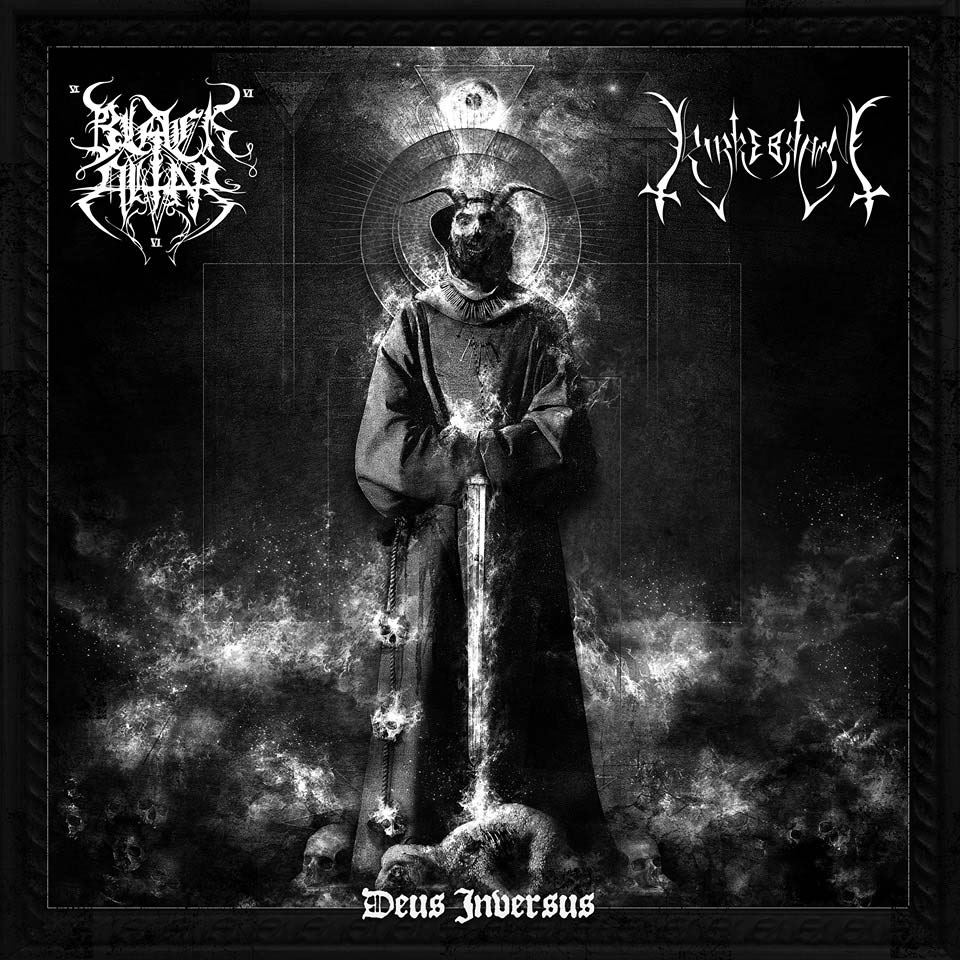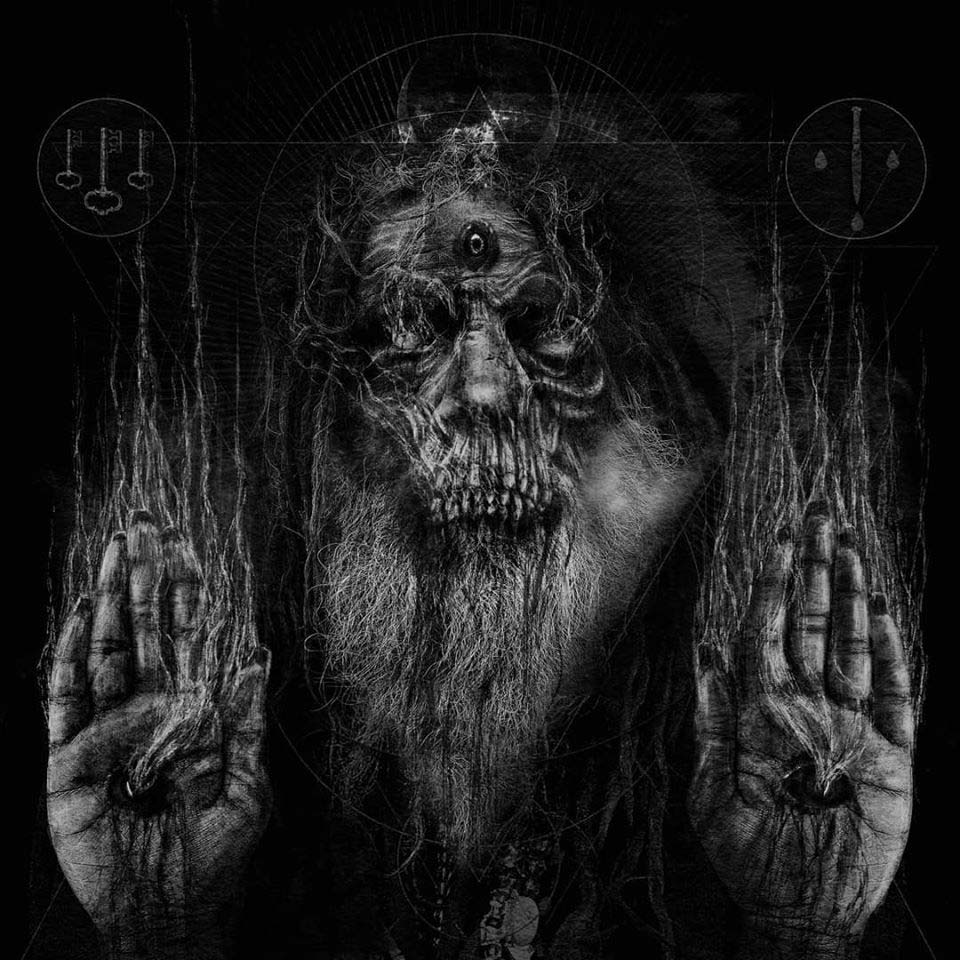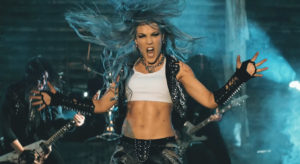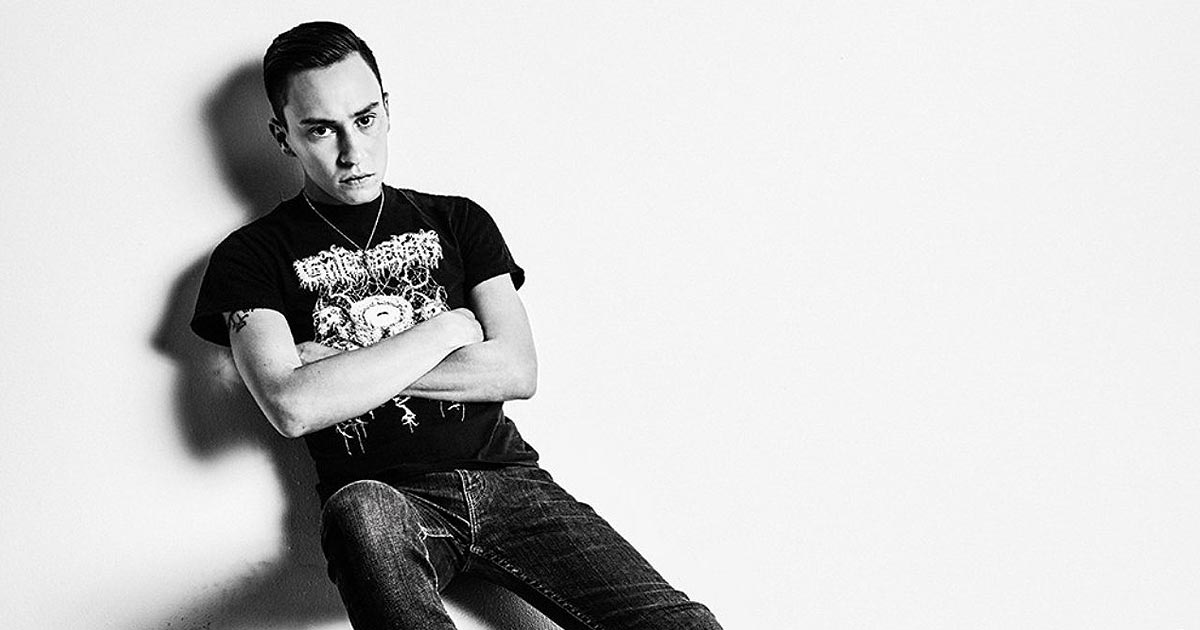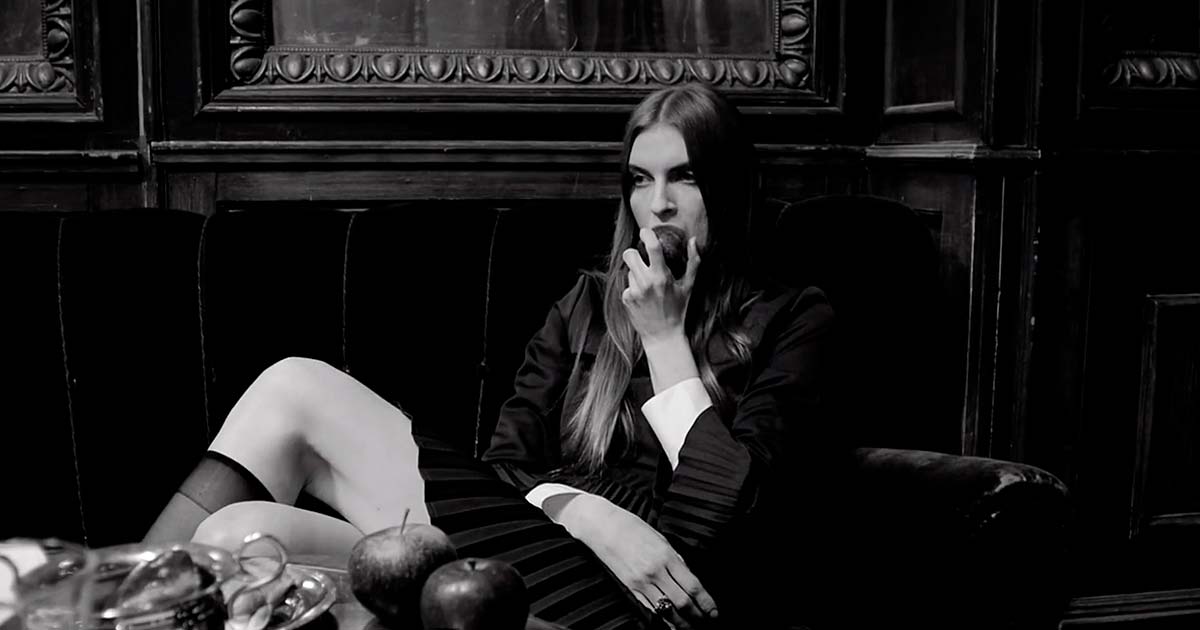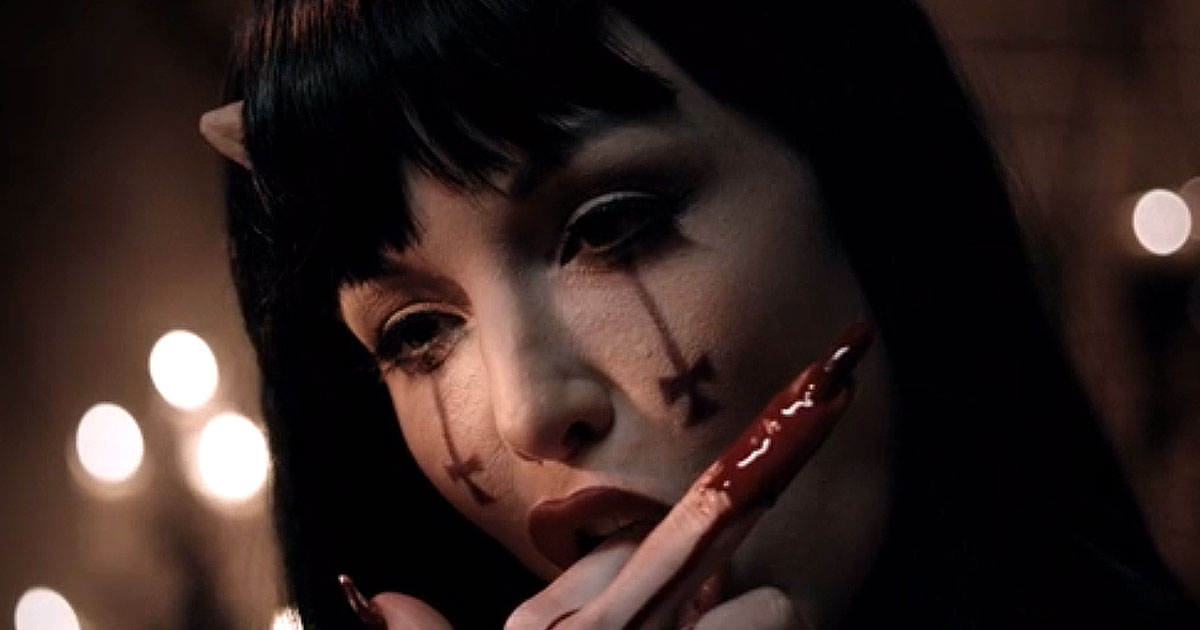¿Cuándo y cómo fue el momento en que sentiste que el mundo de la ilustración te apasionaba tanto, que querías hacer de él tu profesión?
Realmente fue casi por casualidad, aún conservo mi trabajo “común” como diseñador gráfico. Todo el mundo de la ilustración empezó como una coincidencia, era un hobby netamente personal, trataba de emular el arte de bandas de metal y las líricas que desarrollaban, todo como una catarsis de la imaginación. Con el tiempo y la constancia mi trabajo fue creciendo, robando la atención de las personas, de esa manera ha llegado al punto actual, donde tengo la fortuna de ser solicitado para crear ilustraciones dentro del mundo del metal como el editorial.
¿Eres autodidacta o has recibido algún tipo de formación en alguna escuela de arte o de otro tipo?
Tuve un par de clases en mi carrera de diseño gráfico, aprendiendo algunas técnicas de ilustración y dibujo técnico. Años después tomé clases de pintura al óleo. Esto para aprender y familiarizarme con la técnica, pero realmente el conocimiento de la técnica tradicional, como digital y el desarrollo de un estilo, fue de manera autodidacta.
¿Cuáles han sido las influencias más importantes a la hora de desarrollar tu estilo, tanto fuera como dentro del mundo de la ilustración?
La influencia principal es el demonio. Mi primer contacto con el arte fue a través del arte religioso, y esto sería también a modo de influencia sobre la temática de mi estilo actual. Desde pequeño crecí en una sociedad donde la religión católica es uno de los pilares principales. La influencia del mundo “sagrado” impregna su alrededor, con las iglesias, monumentos, festividades, y afiches religiosos por doquier. De está manera, represento lo que es sagrado para mi persona, haciendo una inversión, desacralizando sus piezas, composiciones y conceptos que esta religión predominante impone, y tornando lo blasfemo en algo sagrado.
Dentro del mundo del “arte oscuro” propiamente dicho, mi principal influencia sería HR Giger. Desde pequeño fue una figura que marcó y abrió la puerta a un mundo aterrador, bizarro y grotesco. Había una belleza dentro de su trabajo que me intrigaba muchísimo. El primer contacto fue con la película Alien, su figura del xenomorpho me cautivó al instante, un hechizo por así decirlo, jajajaja. Por aquel entonces no sabía quién era el responsable de diseñar aquella criatura, pero me quedé obsesionado. Con el tiempo volví a tener contacto con Giger, ya que en unas revistas españolas, de tintes esotéricos, mágicos y de ciencia ficción me reencontré con el artista y su bestia. Aquí también conocí artistas como Beksinski y Wayne Barlowe… el resto fue historia.
Con el tiempo descubrí algunas portadas de discos de heavy metal, principalmente de géneros extremos, death y black metal… artistas como: Chris Moyen, Kristian Wåhlin, Michael Whelan, Travis Smith, Seth Siro Anton, etc… Aquello también fue un momento crucial en el cuál decidí que de alguna manera debería realizar arte para estas bandas.
Más adelante fui conociendo y aprendiendo de diversos artistas que se desenvuelven dentro del medio como: Orryelle Defenestrate, David S. Herrerias, Elirankator, Alejandro Montes Santamaria, Manuel Tinnemans, Mitchell Nolte, Samuel Araya, Timo Ketola, Robert W. Cook (Norot), Denis Forkas Kostromitin, Rafael Tavares, Worthless Endeavors, Ars Moriende, José Gabriel Alegría Sabogal, Lupe Vasconcelos ,Enrique Dubost, Nicola Samori, Adam Burke, Diabolus Rex, Santiago Caruso, Karmazid, Daniel Valeriani, Natasha Xavier, Zac Shiffer, Yuri Seima, Daemorph Evilartdominion, y muchos más que aparecen día con día.
¿Hay alguna técnica con la que te guste más trabajar?
Creo que me he acostumbrado un poco más a lo digital, ya que ha sido la técnica más solicitada hasta ahora, lo cuál me ha llevado a experimentar y desarrollar mis habilidades con esta herramienta, obteniendo resultados bastante interesantes, que te motivan a seguir, pero me encanta el dibujo con tinta y el óleo.
Descríbenos un poco el proceso que sigues desde el momento en que te pones manos a la obra en el desarrollo de un diseño. ¿Tienes un método de trabajo definido o dependiendo de algunos factores lo abordas de diferentes formas?
Depende mucho cuando trabajo con un autor o banda. Qué es lo que buscan representar con la pieza o piezas de arte, cuál es el tópico del álbum o de la publicación; así que recolecto toda la información (líricas, ideas, tema y referencias gráficas), hago una investigación y empiezo a realizar bocetos a mano o en digital. Así cuando me dan la aprobación de los bocetos, el proceso comienza.
Voy creando la estructura, y durante el proceso dejo que fluya la creatividad, experimentando con elementos que llegan a mi mente, tratando de que la pieza por si sola se vaya manifestando, desarrollando una personalidad y energía única.
De todas tus obras, ¿hay alguna que tenga alguna connotación especialmente significativa para ti?
En general creo que todas tienen un valor especial, existe un trasfondo detrás de cada proyecto, una misión que se ve retratada en el contenido de la obra hasta hoy realizada. Cualquier trabajo trato de realizarlo dando lo mejor de mi. Obviamente hay un valor agregado cuando lo haces para una bandas que te haya influido a nivel personal… en ese caso podría mencionar a Rotting Christ, Moonspell, Dark Funeral, Manticore, Leviathan, Necrophobic…
Según mi opinión, a día de hoy, el artwork de los álbumes ha alcanzado un mayor protagonismo y un mayor nivel del que nunca tuvo…¿estás de acuerdo con esta apreciación?¿Porqué crees que esto se produjo?. Si no estás de acuerdo explícanos un poco porqué…
Totalmente de acuerdo. Creo que dentro del mundo del heavy el arte siempre ha sido una pieza fundamental, es la manera de complementar o de materializar de manera física la esencia de un sonido que representa a toda una cultura. El arte ha tomado una fuerza bastante considerable en la repercusión de las bandas, refuerza la personalidad del grupo y se ha vuelto una extensión de ellos mismos. Creo que las bandas también se han vuelto más comprometidas. En ese sentido, con su esencia personal y profesionalidad, el arte refleja de alguna manera ese compromiso.
¿Cuánto crees que aporta un buen diseño artístico, a la hora de que una banda llame la atención de un público sobrestimulado, en un marco como el actual, el el que hay tanta oferta musical en todos los estilos?
Muchísimo, es la tarjeta de presentación para la banda, un trabajo profesional en la caratula, retrata el nivel de profesionalidad de la banda, el interés por entregar a los oyentes un material de calidad, una responsabilidad adquirida con su mismo proyecto (inversión en producción, composición, arte, instrumentos, etc.). Inclusive hay álbumes que se apoyan por el autor de la carátula, como anzuelo, reforzando lo que señalaba con anterioridad. Si el artista es bueno y/o reconocido, se puede deducir que el material corresponde a la calidad de la obra gráfica. Aunque existen las excepciones claro (nunca juzgues a un libro por su imagen).
Personalmente creo que facilitaría a la banda entrar o abrirse puerta en el mercado con un buen arte de soporte.
La música, muchas veces sugiere imágenes en nuestro subconsciente, y algunas personas son capaces de concretar estas imágenes en el papel. Seguro que algunas vez has fantaseado con el artwork que tú hubieras hecho para alguno de tus discos favoritos. ¿Podrías decirnos uno de ellos y qué hubieras hecho en su diseño artístico?
Nunca me había hecho esa pregunta, por lo general esos discos ya tienen un diseño excelente. Quizás me hubiera gustado realizar algo para ‘The Time Of No Time Evermore’ de Devil’s Blood o el ‘Reinkaos’ de Dissection. ¿Qué haría…? no sabría decir… pero tendría que existir una figura dominante (un dragón o una representación de la muerte), una abismo, serpientes, fuego. Tratando de crear una especie de pintura o visión “religiosa”.
Que consejo le darías a cualquier persona que está empezando, pero que cree que no tiene el talento necesario o no tiene el apoyo suficiente en su entorno.
Pues que es un camino bastante largo y espinoso, hay que desarrollar la técnica y un estilo propio con la práctica, una mejora y reconocimiento que sólo da la constancia y disciplina. Así que el mejor consejo es la paciencia. Ahora hay muchas herramientas y técnicas que pueden ayudarnos a exponer nuestro trabajo (redes sociales, plataformas artísticas, marketing, etc) pero aunque pagues por seguidores y exposición, si tu trabajo realmente no tiene un contenido (concepto, trasfondo, cultura), una técnica bien desarrollada y lo más importante, un estilo propio, muy probablemente la obra no trascienda y se transforme sólo un objeto que se ve bien.
Nombra a unas cuantas bandas que estén habitualmente sonando en tu reproductor.
Watain, Dissection, Balmog, Deathstars, Mephorash, Gaerea, Contagiion, Vital Remains, Aosoth, Infernal Angels, Vltimas, Necromonicon, Mercyless (Fra) y Mefisto.
Sabemos que esta portada ya tiene unos cuantos años, pero suponemos que para ti supuso un gran impulso trabajar con una banda de tanto renombre como Bloodbath, quisiéramos que no hablases un poco del proceso creativo de la portada que realizaste para el álbum ‘Grand morbid funeral’: en que te inspiraste, la técnica empleada, el tiempo invertido, el feedback con la banda, si hay alguna anécdota a su alrededor…
Pues fue una gran sorpresa. Cuando recibí el mail de Anders Nyström no lo creía, fue algo totalmente emocionante y en un punto, aterrador, ya que era el arte para su próxima producción y eso era algo MUY IMPORTANTE, la gran oportunidad de dejar una marca en la historia. Hablando con ellos parte del concepto ya estaba delimitado, con la plaga, la época victoriana, el concepto del rey rata y una estética antigua, además de una serie de imágenes de mis creaciones para partir de la estética de éstas, así que partí de ese punto. Me enviaron una idea gráfica que partía de una creación que ya había realizado, una Madonna maligna y putrefacta que sostenía un bebé descarnado, del cuál emanaban gusanos. Así que empecé a desarrollar el concepto inicial, aportando ideas, añadiendo elementos y ajustando a las dimensiones necesarias para la portada principal. Después se pasó a la segunda pieza, “El Rey Rata”, del que ya se me había planteado el concepto, que era el retratar el concepto del “Rey Rata” (que consiste en un fenómeno donde una serie de ratas se ven unidas al enredarse su cola) pero formado de cadáveres humanos. En está pieza hubo un poco más de libertad y logré imprimir más mi sello personal, añadiendo toques más al estilo que estaba buscando desarrollar.
El tiempo para crear estas piezas fue relativamente corto para su entrega, cerca de dos meses o tal vez menos. Parece que es bastante tiempo, pero al tener que dividir éste tiempo con mi trabajo “común” y mi vida personal, fue demasiado pesado, además de tener que trabajar con la diferencia de horarios, y esto me llevaba a realizar los cambios como observaciones a altas horas de la noche, pero al final todo valió la pena.
ENGLISH VERSION
How and when was the moment in which you met with your passion about the huge world of illustration and made this your way of living?
Somehow it was a coincidence, i still keep my own job as a ‘general’ graphic designer. It all started as a coincidence. It was a completely personal hobby in which i tried to emulate metal bands’ artwork and the lyrics those bands developed, as an imagination’s catharsis. With time and perseverance, my work grew, attracting the glances, until i reached the point where i am today, in which fortunately i’m requested to create within the metal world.
Are you a self-taught person or did you take lessons at an art-school or any other kind or education?
I’ve had attend a couple of classes in my graphic design career, learning some illustration and technic drawing techniques. Years later i took oil painting lessons. This was to learn and became approach the technique, but really the knowledge of the traditional technique, like the digital one, and developing a particular style, was self-taught.
Which are the most important influences in the development of your personal style, both in and out of the world of illustration?
The main influence is the devil.
My first contact and like a strong influence in it’s subject was religious art. Since i was a child i was raised in a society where catholic religion is one of it’s main pillars in it’s structure, the influence of this ‘sacred world’ impregnates all, with it’s churches, monuments, holidays and religious imagery everywhere. In this way I represent what is sacred for me. twisting it, desecrating its pieces, compositions and conceptions that this dominant religion imposes, turning the blasphemous into something sacred.
Within the world of the ‘dark’ art itself, the main influence is H.R.Giger. From my infancy he has been a figure that marked me and opened the door to a horrifying world, bizarre and grotesque, and at the same time there was a beauty within his work that caught my attention since a young age. Obviously, the movie Alien was my first contact, his xenomorph figure captivated me at first sight, like a spell hahaha. I didn’t know who was the creator of said creature which i became obsessed with. With time i got in touch with Giger creations again, in some Spanish magazines, related with esoteric, magic and scy-fi as well (aliens, time travel, conspiracies..). I found myself again in front of the artist and his beast, as they sold posters of him, as well as another artist like Beksinski and Wayne Barlowe…and the rest is history.
With time I discovered heavy metal covers, extreme genres mainly, like death and black metal, and with artists like Chris Moyen, Kristian Wåhlin, Michael Whelan, Travis Smith, Seth Siro Anton, etc…
It was a turning point in which i decided that i at some point in the future i should make art for these bands.
With time i knew and learned from several artists of the scene like Orryelle Defenestrate, David S. Herrerias, Elirankator, Alejandro Montes Santamaria, Manuel Tinnemans, Mitchell Nolte, Samuel Araya, Timo Ketola, Robert W. Cook (Norot), Denis Forkas Kostromitin, Rafael Tavares, Worthless Endeavors, Ars Moriende, José Gabriel Alegría Sabogal, Lupe Vasconcelos ,Enrique Dubost, Nicola Samori, Adam Burke, Diabolus Rex, Santiago Caruso, Karmazid, Daniel Valeriani, Natasha Xavier, Zac Shiffer, Yuri Seima, Daemorph Evilartdominion and a lot more that appear day by day.
Do you have any special technique you love to work more compared to others?
I think i became more comfortable with digital, as it was the most requested technique up until now, which led me to experiment and develop my skills with this tool, obtaining quite interesting results, which motivates you to go on, but i also love drawing with ink and with oil.
Could you describe to us the entire process you follow in the creation of any album’s artwork. Do you have a predefined method or do you follow different ways depending on other external factors?
It depends if i work with an author or a band. What they want to represent with the art, what is the story of the album or the publication…so i get all of the info (lyrics, ideas, topics, graphic references…), make a research and start to make manual or digital sketches. So when they approve the sketches, the process itself starts.
I create the main structure, and along the process i let the creativity flow, experimenting with the elements that come to mind, trying to make the work manifest itself, developing a unique personality and energy.
Among all of your works, is there any of them with a special personal meaning for you?
They all have their special value. and there is a background behind each project, a duty that is portrayed by the content of the work done until this moment.
I try to give my best in every work, obviously there is an added value when you work for some of those bands that influenced you to reach the point where you are now…i could mention Rotting Christ, Moonspell, Dark funeral, Manticore, Leviathan, Necrophobic…
In my opinion, the artwork nowadays is more important than ever in the music world, and it has reached the highest level in many years by it’s own value. Do you agree with this opinion? If you think so, in your experience, what’s the reason for this?. Or if you don’t think so, tell us the reasons why.
I totally agree. I believe that within the heavy metal world, artwork has always been a main part. It’s the way to complement or materialize in a physical way the essence of the sound that represents a whole culture.
The artwork has taken quite a considerable magnitude in band’s attractiveness, it reinforces the personality of the band and it becomes a expansion of the band itself, and i think that the bands are more committed to themselves, with their essence and professionalism, and in some way the art represents that commitment.
In these days of overstimulated people and the continuously growing number of bands out there… How high is the value of a good artwork to bring peoples’ attention to a band?
A lot. It’s the business card for the bands, the professionalism in the cover artwork, portrays the professionalism of the band itself, the interest in giving the audience a quality product, a responsibility acquired with their own project (in the form of investment in production, composition, artwork, instruments etc)
There are even albums that use the artwork’s illustrator like a hook, strengthen what i’ve said before. If the artist is good and/or recognizable one, it can be deduced that the music fits with the quality of the artwork. Although exceptions exists, of course (never judge a book by its cover).
Though, personally, i think that it make it easier for a band with good artwork to open the doors of the market.
Music suggests images in our own mind, and some of you have the ability to put those images on paper. Sure, you must fantasized about creating the artwork for some of your favourite albums. Can you tell us one of them and what you would have done on that occasion?
I’ve never ask myself that question. Usually those albums already have great artworks.
But in this moment, perhaps, i would like to do something with ‘The time of no time evermore’ from The Devil’s blood or ‘Reinkaos’ from Dissection… What would i do? In this moment, i wouldn’t know…but it would involve a representation of a prevailing figure (a dragon or the death), an abyss, snakes, fire…aiming to create some kind of a religious painting or vision.
Tell us some advice you could give to those who are taking their first steps into the world of illustration but they think don’t have enough talent for it, or don’t feel supported by the people in their environment.
Well, it’s a long hard way, you have to develop your own technique and style with practice, and improvement and reconsignment only comes with discipline and perseverance. So the best advice is patience.
Now there’s a lot of tools and technique that can help us to show our work (social network, artistic platforms, marketing etc), but, even if you pay for followers and exhibition, if your work doesn’t have a subject (concept, background, culture…), a well developed technique and the most important, a style of your own (identity), probably it will not transcend and it only will become a ‘good looking object’.
Tell us a bunch of bands that usually sounds on your stereo.
Watain, Dissection, Balmog, Deathstars, Mephorash, Gaerea, Contagiion, Vital Remains, Aosoth, Infernal Angels, Vltimas, Necromonicon, Mercyless (Fra) and Mefisto.
Tell us something about this work. What was your inspiration, technique used, how much time it took you to complete, the feedback from the band, any funny thing that happened during the making of…
It was a pleasant surprise, when i received an e-mail from Anders Nyström I barely could believe it. It was something completely exciting and a bit scary, because it was the art for their next album and that was something VERY IMPORTANT, a great chance to leave a mark in history. I received their feedback, the concept was made up, with the plague, the Victorian age, the ratking concept and the old aesthetics, also a serie of images of my own creation to follow their aesthetics, so i started from that point. They sent me a graphic idea from a creation i made before, a rotten malignant Madonna who was holding a gaunt baby, from which emanate hungry worms. So i started to develop the concept given to me by the band , adding ideas and elements and adjusting it to fit the required dimensions of the cover. Several proposals were presented, but finally this made it as the final piece. Then came the second part: the ratking. The concept that was already captured, was creating the portrait of the ratking (it consists in phenomenon in which, in short, several rats got together because their tails got tied and stuck) by shaping human corpses. In this work i could express a bit more freely and i could leave in a greater grade my personal style, adding things in the way i was trying to develop. The time to complete these pieces was relatively short, about two months, or maybe less. It seems enough, but during this time i had to deal with my ‘common’ work and my personal life, so it was a bit too much, and also deal with the differences in time zone, so i had to make changes during late night hours, but in the end, it all worth the effort.

